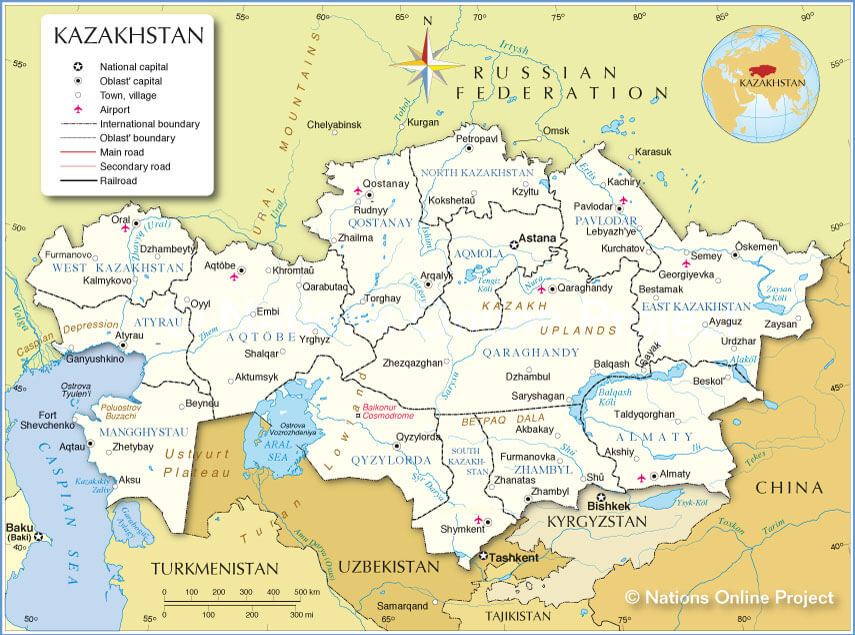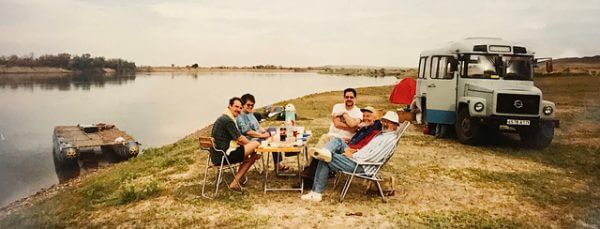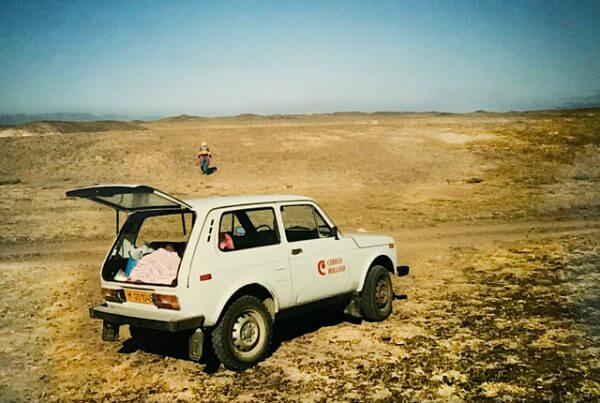#35: Kazakhstan, 1996Floating Down the Ili River & Trekking to Charan Canyon
As always when overseas, we had the opportunity to enjoy tourist excursions while living in Central Asia. Not only the trip along the Silk Road as chronicled in Post #32, but lesser known sights like the Ili River and Charan Canyon.
[Click on photos to enlarge.]
Ili River
June 27
We’ve had a wonderful visit this week with Frank Olson, Russell’s law school friend, visiting Valodya’s mountain dacha and the Uzbek Circus with its amazing horsemen performing the seemingly impossible. We’ve also organized a westward Silk Road trip for him next week.
Tomorrow, we’re taking a two-night trip on the Ili River to visit Nightingale Island. We’ve invited three friends to join us, and we expect a fine old time. We’ll leave after work and travel a couple hours to the base camp, where we’ll spend the night. The next day, we float/paddle down the river to the island, where we’ll rest Saturday night. We’ll return Sunday. It promises to be refreshing and fun. Each family is bringing some treats to supplement the menu furnished by the local team which conducts the trip.
July 4
Friday evening, we were driven to the river in what looked like nothing so much as an old school bus which had been repainted. There we met the rest of the team — leader, cook and two general helpers. They worked together to set up tents and cook dinner while we munched on snacks and told tall tales.
Two young men suddenly pounded up on the squat little ponies that carried the Mongols across Asia and on to threaten Europe. The riders wanted to talk and, we suspected, see if we’d offer them vodka. After a while, when no vodka was forthcoming, they suddenly pounded off upriver and home.
That night, none of us slept well, a combination of being out of practice sleeping on the ground with just a thin insulite pad underneath and the noisy folks across the river who’d obviously brought a lot of vodka. Even that could be overlooked, because R&I, when we got up to answer the call of nature, were thunderstruck by a magical sky full of stars with no man-made glare to obscure them.
The next morning, after a fine breakfast of eggs and bread and tea, Russell and I went for a stroll on the bluffs above the river. Russell’s sharp eyes caught sight of movement on the horizon — a large herd of Bactrian camels heading for the river. Scores of them — all sizes, all colors, both genders and totally untended by a herder.
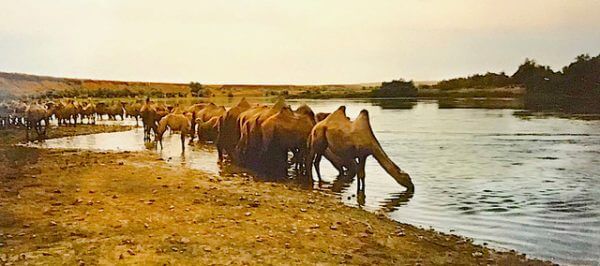 Cautiously, we walked toward them, taking pictures but fearing not much would show without a long lens. All herding animals have sentinels, and these camels had two big males who observed us carefully, their heads lowered and intent upon the approaching two-legged duo. We stayed at a safe distance and watched as first one camel, then another, then the whole herd came down a draw to the water. As we waited quietly, some approached not more than 20 feet away. It was truly awe-inspiring to be so close to so many with no zoo bars, no circus ring, no herdsman. They were just there, so many of them that the river bank and the bluff were hidden by their bodies and the dust raised by their wide pillow-feet.
Cautiously, we walked toward them, taking pictures but fearing not much would show without a long lens. All herding animals have sentinels, and these camels had two big males who observed us carefully, their heads lowered and intent upon the approaching two-legged duo. We stayed at a safe distance and watched as first one camel, then another, then the whole herd came down a draw to the water. As we waited quietly, some approached not more than 20 feet away. It was truly awe-inspiring to be so close to so many with no zoo bars, no circus ring, no herdsman. They were just there, so many of them that the river bank and the bluff were hidden by their bodies and the dust raised by their wide pillow-feet.
[If you like, refer to the lower right of the map above for the lakes and river mentioned in the next paragraph.]
Finally, reluctantly, we had to scramble back to camp and climb on board for our trip down the Ili. The river originates in China and flows from the Tien Shan Mountains all the way through man-made Lake Kapchugai to God-made Lake Balkhash. We traveled on part of the stretch between the two lakes. The support team assembled a pontoon boat from two blue-and-yellow, torpedo-shaped floats plus pipes with webbing strung between them. It was like a big Tom Sawyer raft, holding eight people and all their gear with no problem. Three support staff went ahead by bus to set up the night’s camp.
The Ili is a gentle river, quite wide, though swift-flowing, and I soon fell asleep, lulled by the sound of water and the soft cries of birds. Both Russell and Frank are great bird-watchers. Frank had brought the definitive guidebook from the States, and the two of them soon had everyone involved in trying to spot the Himalayan Ruby-throat, the Asian Paradise Flycatcher and the Great Tit. And they did! From time to time, folks who felt like it would pop over the side for a swim and then climb easily back onboard. I dozed under the sun and inside my life-vest, happy to give myself up to deeply desired rest.
Except for one incident, when several voices awoke me, crying, “What’s that? What’s that?” I opened one eye long enough to see the shape of a bird flit by my hatted head. “Fas’ bird,” I said and went back to sleep. The result was our new watchword. “Fas’ bird” became the default for everything we couldn’t identify, ornithological or not.
We stopped at noon on an island, where the leader and the cook fixed us a hot meal of soup, bread and cookies. Everyone — myself included — took another swim, and then it was back on the boat for the rest of the trip to Nightingale Island. When we arrived, the tents were set up, dinner was simmering in the pot, and the nightingales were singing as promised. The team had ferried all the goods from the bus parked some distance away across the river to the island by kayak!
For after-dinner entertainment, the six English-speakers decided to do one round of Charades. And then we did another. And another and another until it was too dark to see anymore. I never laughed so hard in my life. See what you can do acting out “Things go better with Coca-Cola,” “Cruising Down the River” and “Bee-bop-a-lula.”
This is probably as good a time as any to talk about Ruslan, the leader of our expedition. A former bronze-medalist in the kayak at the Russian Games, he decided to put his talent to work and organized an outdoor-tour firm. In addition to our patty-cake, float-down-the-river trip, he offers white-water canoeing, trekking in the mountains, and a three-day, over-the-glacier tour to Lake Issykul in Kyrgyzstan. He had such quiet dignity that I think we’d all follow him on any of those adventures if only our legs and lungs would hold out.
I should also mention the cook, a wiry little man, old but still flat-bellied and tough, a former professional hunter who needs a slightly easier life now that he’s gray, and who’s about the best camp cook I ever knew. Proof of the pudding: for breakfast on Nightingale Island, we had blinis with fresh loganberry syrup. He got up early, picked the berries and made the syrup while we were still snoozing away.
Once we’d filled our tummies to bursting, we took it easy, just reading, strolling on the island, etc. The bus driver wanted to do some fishing, so Ruslan took him upstream on the pontoon-boat to get away from the camp. Russell and one of the other male guests went along for the ride and a hot hike across the steppe to see pheasants. But the birds were smarter than the men; they didn’t appear in the heat of the day. When it was time to go get the driver and his one lone fish, I went along for the ride but didn’t wander off to find pheasants.
After lunch, they broke camp and ferried us across the river, where we all sat in the shade of some Russian “olive” trees (not really, olives, but that’s what they’re called) amid breezes off the river, while the boat went back for all the gear. Once on the bus, we sang our way to Almaty — “Bali Hai,” “If I Had a Hammer,” “Oklahoma,” “Down by the Old Mill Stream” and scores more. Frank sings in a barbershop sextet, so he kept us mostly on key, and the rest of us made up with enthusiasm for what we lacked in talent. Gosh, it was a good trip, and I wouldn’t hesitate to recommend it to anyone who’s interested.
Charan Canyon
October 18
Thursday morning, we were talking with my friend Barbara Holloway about seeing Charan, Kazakhstan’s Grand Canyon. That afternoon, completely independently, Valodya suggested a trip there for the coming weekend, saying the weather wouldn’t be good enough for much longer. (We’ve been having a wonderful Indian Summer; what do they call it here — “Mongolian summer”??) The coincidence of these two conversations made up our minds, and we organized a three-family trip for Saturday.
Barbara and her husband Tom plus two young daughters filled their Niva, and we took Valodya, wife Ludmilla and daughter Katya in ours. We left about 8:00 a.m. and should have arrived around noon, but various delays and detours added another couple of hours.
Even so, the trip was a happy event. We were traveling on the Silk Road in the direction opposite to all our previous journeys, and it was a thrill to see this part of the country. The more we travel the Silk Road, the more we appreciate what an undertaking it must have been in the days of caravans and bandits. Even now, it’s not an easy trip, and one can imagine the hardship of doing it on foot, camping out most nights, suffering from heat and cold, perhaps losing everything when robbers turned up.
We drove first through agricultural fields and small towns (one of them Valodya’s boyhood home, where we had a mini-tour at his invitation). The snow-capped Tien Shan Mountains towered on our right with gold, dry foothills below them. Then we left the greenbelt around Almaty and travelled through scraggly steppe for miles — a landscape which has a sere beauty of its own, but it takes a while for a girl raised in West Virginia’s green hills to savor it.
Next, we came to a barrier of dark brown, craggy mountains, not nearly so high as the gray Tien Shan, but formidable just the same. The road started up through a stream-carved defile. Up and up we went, never at a very steep grade, but always up. A fascinating landscape, both harsh and intriguing, like something out of a childhood fairy tale where the hero or heroine must travel through terrible terrain in order to find the ogre and win the prize.
Our prize was a high plateau. At the top of this long defile was a dry, flat, almost barren plain that stretched to the horizon where we could discern another set of craggy brown mountains. On and on we drove, appearing never to get closer. Suddenly, there they were, up close, those mountains we’d been traveling toward for, it seemed, a very long time. Just as we started to ascend into them, a dirt track led off to the left. We skirted the base of these crags, glad to be in the Niva because the track was so rutted and eroded.
Rather than continue to the canyon’s rim, Valodya insisted on searching for a hidden track down to the bottom of the gorge. He suggested one sidetrack after another, but that’s exactly what they were — sidetracks leading nowhere. This went on for an hour until Russell and I declared we’d stay on the main track and forego the pleasure of driving through the canyon’s bed. Once we’d put our foot down, we stayed on the main track and arrived at the rim within 20 minutes.
Not as big or as deep as our Grand Canyon, Kazakhstan’s Charan Canyon is spectacular just the same, especially because it’s such a journey to get there. The depth is said to be about 40 meters [130+ feet], but it looked like more than that to us. From the rim where we stood, we could see, far below and way off, the emerald green of the Charan River which cut the canyon through eons.
We sat down for a picnic beside the main ravine at 2:00. When we finished, Barbara and Tom had to return to Almaty because they had an engagement that evening. They didn’t get to see much of the canyon, but they were gracious enough to say they were pleased to have seen what they did and to know how to find it, so they could return another time.
All the Americans expressed regret that we didn’t have more time to explore. We’d have liked to stay at least overnight so we could hike down into the canyon (none of us keen to contribute to the downgrading of that special environment by driving a Niva through it).
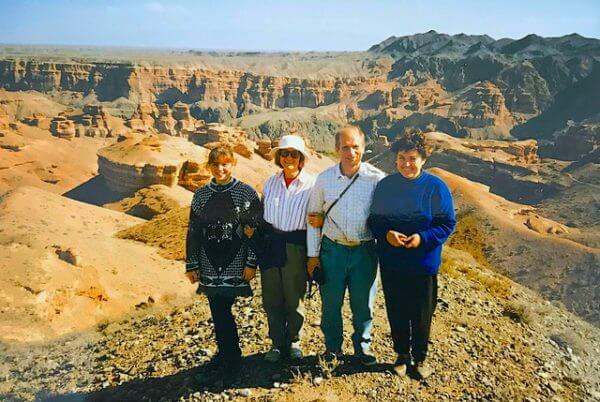 After the Holloways left, the Fedorovs and R+N took another hour to hike out onto a couple promontories so we could look down into the canyon’s wonderful colors and shapes. We talked about returning with tents, food and water so we could stay for a weekend.
After the Holloways left, the Fedorovs and R+N took another hour to hike out onto a couple promontories so we could look down into the canyon’s wonderful colors and shapes. We talked about returning with tents, food and water so we could stay for a weekend.
I did all the driving in our car, and I thoroughly enjoyed it. Russell hasn’t had much practice with the Niva, so we decided it made more sense for me to drive. Besides, I like to drive. I think I enjoyed the return trip more than the way out — back across the plateau, down the defile, across the steppe and back into agricultural land. It was like a voyage through a landscape imagined for the movies, except it was real. Now that we’re about to leave Kazakhstan, I wish we had more time to travel the Silk Road, to see more of the landscape of Central Asia and to experience more of the history and natural features. Such is life. We’ve seen a lot, and it’s always better to leave when you want more than when you feel you’ve exhausted all that a place has to offer.
[Sadly, our busy schedule during our few remaining weeks in Almaty made an overnight return to Charan impossible.]

COMING NEXT MONTH
Kazakhstan-Italy, 1996
Finding a Home of Our Own

LET ME HEAR FROM YOU.
Please take a moment to share your thoughts.
Your comments help make the blog better, and I always answer.
* * *
If you enjoyed reading this post, I hope you’ll SUBSCRIBE by clicking on the button below. Every month, when I post a new excerpt from my life overseas, you’ll get an email with a link so you can read the next installment. Subscription is free, and I won’t share your contact information with anyone else. Your subscribing lets me know you’re reading what I write, and that means a lot.

